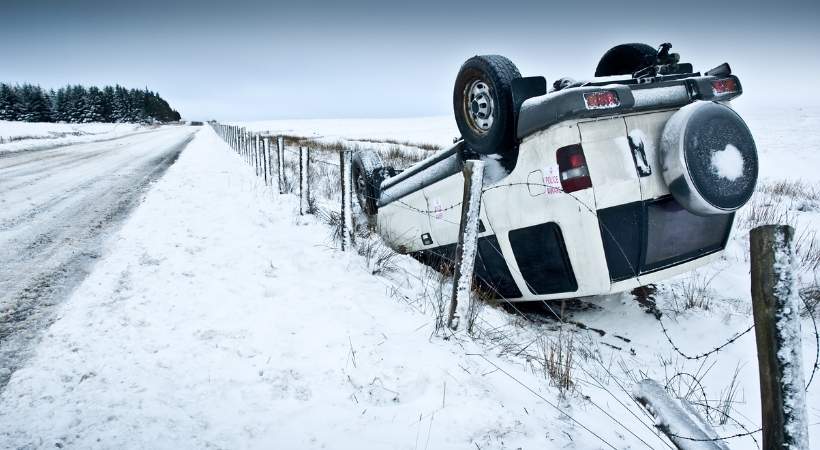Ins and Outs of Applying for Driving License in Canada
Driving License in Canada: Passenger Vehicle and Motorcycles
Getting your driving license in Canada varies from province to province. Sometimes, it may be possible for you to drive with your home country's driving license, for a limited amount of time. You must first get familiar with the road signs in Canada, since they are often quite different from other, non-North American signs. The traffic lights, the traffic laws, DUI laws... all can be different from what you're used to.
"A valid International Driving Permit (IDP) issued in other countries can be used in Canada for a short period. The time period varies so check with the relevant provincial or territorial government for details. Driving licences can be exchanged at provincial/territorial Driver Licencing Offices. In all cases, the applicant will need to prove that they fulfill residency requirements by presenting proof of permanent residence and/or a work visa." - angloinfo.com
In all provinces and territories of Canada, to be legally in control of an automobile, sport utility vehicle, pickup truck or RV you must:
- Have a legal automobile driver's license
- Have insurance on the vehicle
- Ensure that the vehicle is registered annually and have a valid sticker in the proper placement on your license plate.
- The driver is also responsible to make sure the vehicle is in a safe condition and meets emission standards, if applicable.
Get more details about driving in Canada from the government website.
It is now law that all young drivers 21 and under, regardless of license class, must have a blood-alcohol level of zero. We will cover driving in Canada for passenger vehicles and motorcycles.

1. Alberta:
Students may drive an automobile using their country’s driver’s license and an International Driver’s license for up to one year. You must also carry both with you at all times that you are driving.
Depending on which country you come from will determine whether you can do an exchange without any tests; however, you will have to show proof, from your government, that you have more than two years of experience. You will need that translated to either French or English.
Alberta - Exchanging your license.
Students may drive on their country’s license for their complete study period, as long as they are valid. They must carry their study permit with their license. If their license is not in English, they must carry a certified translation or an International Driver’s Permit with it. You may get an Alberta ID card if you wish.
If your license expires, then you must apply for an Alberta license. Contact the SIU, and you may get the experience you gained while holding the Alberta ID card credited to your driving record.
For spouses: If you have a license from a country, as noted in the Québec details, plus the Republic of Ireland, you can do a simple exchange.
If your license is from another country, you will have to check to see if you qualify for the Graduated Driver’s License exemption. You will be given an application. Next, you will have to pass a knowledge test. Your license, GDL exemption application, and supporting documents will be sent to the Alberta government for review.
Drivers from Fiji, Hong Kong, Kenya, and Saudi Arabia have special license verification requirements. You will also need certified proof of your driving experience. You then may be credited for one or two years of experience. You will have to pass one of the two types of road tests no matter what.
For more information, check out the following:
https://www.alberta.ca/exchange-non-alberta-licences.aspx
https://www.alberta.ca/assets/documents/drivers-licence-gdl-exemption.pdf
https://www.alberta.ca/mandatory-entry-level-training-for-class-1-and-2-drivers-licences.aspx
Alberta - For Motorcycles
As long as your home country license and study permit are valid, you may drive in Alberta. You may wish to obtain an Alberta ID card if you choose to apply for an Alberta license in the future. The time spent driving while you had the ID card can be credited against your new license.
You must carry an official translation of your license (or an International Driver’s Permit) as well as a copy of your registered school courses, your study permit, license, valid insurance, registration, and vehicle license at all times.

2. British Columbia:
International students may drive with their country’s license and a certified translation or with an IDP for one year. You must carry your study permit and student I.D. After this time period, you must get a BC license.
British Columbia - Exchanging your license
You will be required to provide your driver's license history from when you first got a license to the present. This official, the original document must be in English or French or be accompanied by a certified translation.
If your license is from one of the following:
Austria
Australia
Belgium
France
Germany
Guernsey, Isle of Man, Jersey
Ireland
Japan
Netherlands
Except former territories in Antilles: Aruba, Bonaire, Curacao, Saba, St. Eustatius, and St. Maarten.
New Zealand
South Korea (not motorcycles)
Switzerland
Taiwan (not motorcycles)
If you're from Taiwan, you will only be able to exchange your license for a passenger vehicle license. You must provide the following documents:
Taiwanese driver's license card,
Verification certificate of driver's license with red seal stamp (available in Taiwan only), and a translation of your driver's license by the Taipei Economic and Cultural Office (TECO) in Vancouver. You can get an ICBC translation form at any driver licensing office.
United Kingdom (includes England, Wales, Scotland, and Northern Ireland)
United States (includes Washington DC and Puerto Rico)
Follow these steps for passenger vehicle licenses (class 5) or motorcycles (class 6).
Book an appointment to visit an ICBC driver licensing office and bring the following to apply for your license:
Your current driver's license
If your license or driving record is in a language other than English, an ICBC-approved translator located in B.C. will need to translate your documents.
If you’re from any other country not listed above, you can still apply for a B.C. license, but in addition to the application, you will need to take a knowledge and road test.
https://www.icbc.com/driver-licensing/moving-bc/Pages/Moving-from-another-country.aspx
British Columbia - For Motorcycles
You may continue to drive on your current license if you have a valid student exemption due to full-time enrollment at a designated educational institution in B.C. If the license is not written in French or English, then the student must get an official translation done and carry it and their study permit at all times. You must wear a helmet. Your vehicle must be registered, licensed, and insured for road use.
Mopeds and scooters - Vehicle registration

3. Manitoba:
You can drive a passenger vehicle with your out-of-country license for a period of three months. In addition, you have only three months to apply for a Manitoba license. If your license is not written in English or French, it is best to obtain an IDP from your country; otherwise, you must carry a certified translation of your license with you.
Manitoba - Exchanging your license.
For Switzerland, Great Britain, South Korea, Germany, and the US, you may exchange your license without taking a written or road test. US students are permitted to drive with their State license without having to exchange it.
You will have to pass both a written test and a road test for citizens of other countries. Upon passing both, you may immediately apply to exchange your license.
https://www.uwinnipeg.ca/student/intl/information-for-new-students/drivers-licensing.html
Manitoba - For Motorcycles
If you are a full-time international student residing in Manitoba, and you come from one of the following countries (Australia, Isle of Man, Northern Ireland, Switzerland, Ireland, UK, or the USA), you may drive with your foreign license.
Riders from a few of the above countries have specific regulations before they can get the Alberta license. You must have a certified translation of your license, your study permit, insurance, vehicle registration, vehicle license with you at all times.
For students from any other country, you may only drive with your foreign license for 90 days before having to change to a learner’s permit. If you have more than 15 months' experience, you may be able to get credit for this time.

4. New Brunswick
As a student, you may drive with your home country’s license, as long as it is valid. If it is not in English then you must have an IDP.
New Brunswick - Exchanging your license
Before the IDP expires after one year, you must apply for a New Brunswick license. You will have to pass a written, a vision and a road test; except, if you are from the following countries: Austria, Australia, Belgium, Denmark, England, France, Germany, Isle of Man, Ireland, Italy, Japan, Netherlands (Holland), New Zealand, Norway, Portugal, Scotland, Republic of Korea (South Korea)*, Spain, Sweden, Switzerland, Taiwan* and Wales. Drivers from Taiwan and Korea have special requirements.
New Brunswick - For Motorcycles
International students who have a motorcycle endorsement on their foreign license don’t have to switch, but can switch to an NB license, with the endorsement, only if they come from one of the following countries: Taiwan, Republic of Korea, Austria, Australia, Belgium, Denmark, England, France, Germany, Isle of Man, Ireland, Italy, Japan, Netherlands (Holland), New Zealand, Norway, Portugal, Scotland, Spain, Sweden, Switzerland, and Wales.
For a moped (less than 50cc), the rider must pass a written and a road test.

5. Newfoundland and Labrador:
International students arriving in Newfoundland and Labrador to study have a period of three months to exchange their driver’s license for an NL one. If your home country’s license is in a language other than English or French, you must provide a certified translation or an International Driver’s Permit.
You must also bring a certified, detailed history of your license, from your home country.
Newfoundland and Labrador - Exchanging your license
For drivers from outside of Canada, your experience will be rated against the Newfoundland system and you will go from there. For US drivers that are at least 17, the process is much simpler. Both groups have to provide valid driver’s licenses and the Identification Documentation - Digital Government and Service NL.
If you come from Germany, Austria, France, the Isle of Man, Switzerland, UK, Republic of Korea, Northern Ireland, Japan, or Taiwan, you can exchange your existing license without taking a visual, written, or road test, as long as you are over 17, you present the required doc and your license is valid,
For residents of all other countries, you must be 16, present ID as specified above, complete a visual, written, and road test.
Newfoundland and Labrador - For Motorcycles
Motorcycle licensed drivers taking up residence in the province will have their experience rated against the Newfoundland system and will be placed in the appropriate phase. Age, driving experience, and a class of license currently held will determine placement.

6. Nova Scotia:
An international student may drive up to 90 days on their foreign license. After that, they will have to apply for a Nova Scotia Driver’s License.
Nova Scotia - Exchanging your license
If you come from Austria, Germany, Isle of Man, South Korea, Taiwan, Great Britain, Northern Ireland, you can do a simple exchange after:
A vision test
Disclosing medical conditions or disabilities that could affect your ability to drive
Providing a certified translation of your license, if it’s not in English or French
Surrendering your license
And paying the regular fees for a license
For other countries you will have to:
Pay for, book, and pass both a knowledge test and a road test
Complete a vision test
Nova Scotia - For Motorcycles
If you are attending school as a full-time student, you may exchange your out-of-province/country license for a Nova Scotia driver’s license for a fee of $25.10. The expiry on your Nova Scotia license will be the same as the expiry on your license being exchanged (up to five years).

7. Ontario:
You can use your foreign driver’s license for a period of 60 days. It is advised to also carry an IDP if your license is not in English or French.
Ontario - Exchanging your license
If your license is from one of the following, Australia, Austria, Belgium, France, Germany, Great Britain, Ireland, the Isle of Man, Japan, New Zealand, Northern Ireland, Republic of Korea, Switzerland, Taiwan, or the United States, you must pass a vision test, surrender your license and pay the license fee.
For all other countries, you must pass a vision test, a knowledge test, pay all applicable fees and provide acceptable proof of identity to receive a G1 license.
The applicant may take their G1 exit test with 12 months of combined Ontario and foreign experience.
The 12-month waiting period will be reduced to eight months with the successful completion of a ministry-approved, beginner driver education course.
Applicants are required to provide adequate proof of foreign-licensed driving experience. However, the ministry may accept an applicant’s declaration of their foreign-licensed driving experience for up to 12 months.
For more than 12 months’ experience, applicants must provide an authenticated letter from their embassy/ consulate or licensing agency in English or French. A full 24 months of Ontario and foreign experience is required prior to attempting their G2 exit test.
The only experience within the past three years may be credited.”
Rules of the road, driving customs and signs vary from place to place; therefore, it is advisable to familiarize yourself with those of the province or territory where you will be studying.
Ontario - For Motorcycles
International students may ride a motorcycle, moped, motorized scooter, or three-wheeled motorcycle, using their home country’s license, for 90 days maximum. At this point, they will have to go through the graduated licensing program, from the beginning, except for riders from Australia, New Zealand, Northern Ireland, Switzerland, and Taiwan.
These individuals are permitted to exchange their full (No conditions/not a ‘learner's) motorcycle license for an Ontario ‘M’ class.
However, individuals who have a full motorcycle license from their country AND can prove their experience (Time) may get some credit for that time, towards an Ontario Class ’M’ license.

8. Prince Edward Island:
An international student may drive for as long as their license is valid, but accompanied by an IDP if their license is not written in English or French. This means that you will have to apply for a PEI license before a year is up since all IDPs are valid for only one year.
Prince Edward Island - Exchanging your license
If your license is from Taiwan, the USA, UK (including Northern Ireland and the Isle of Man), Australia, Austria, Japan, Germany, France, or Switzerland, you must pass a vision test, pay the appropriate fees and provide the required documents in person at any Access PEI location.
If your license is not from one of those countries, you must pass a vision test, complete a written knowledge test on the rules of the road, complete the Novice Driver Course for Newcomers (NDCN) and successfully complete a driving test.
Prince Edward Island - For Motorcycles
Individuals attending university or college full-time may drive in PEI with their motorcycle license as long as it is valid and, if required, accompanied by an International Driver's Permit.

9. Québec:
As a student, you may drive for a maximum of 6 months on your country’s driver’s license. If your license is written in a language other than French or English, Québec prefers it if you get an International Driver’s License from your country.
Québec - Exchanging your license.
If your license was issued in Austria, Belgium, England, France, Germany, Isle of Man, Japan, the Netherlands, Northern Ireland, the Republic of Korea, Scotland, Switzerland, Taiwan, U.S.A.(If you are 16 or older), or Wales, you may exchange your license, without having to take any tests. This does not apply to motorcycle licenses.
If your license is from a country not listed above, you may receive an equivalent license, allowing you to drive an automobile after passing the required tests (Written and driving). You will need to be able to prove, with a certified document from your government, that you have more than 24 months of driving experience. Failing that, you will be issued a probationary license until you have met the two-year requirement.
If you don’t meet the above requirements, you must meet the regular graduated license requirements.
https://saaq.gouv.qc.ca/fileadmin/documents/publications/driving-vehicle-quebec.pdf
Québec - For Motorcycles
International students attending school in Québec may ride a motorcycle, moped, or scooter using their home country’s license. The license must be valid and must be for the type of vehicle that you are using. If the license is not written in French or English, then the student must get an official translation done and carry it and their study permit at all times.
All motorcycle riders must carry insurance, a license, and ownership in Canada plus have a valid registration displayed. All riders must wear an approved helmet, except for Sikh operators and passengers who meet the requirements outlined in Regulation 610 (6)).
Your vehicle must be registered, licensed, and insured for road use.

10. Saskatchewan:
Full-time students attending approved educational institutions, as well as their immediate families, do not have to exchange their driver's license during the time they are living here to attend classes.
An international driving permit (obtained in your home country) is not required but is strongly recommended for any foreign license that is not written in English or French. Without the IDP, you should carry a certified translation of your license.
Saskatchewan - Exchanging your license
If your license is from one of the above-noted countries, You can receive a Saskatchewan license. If it is from another country, You will have to complete steps from the Graduated Driver’s Licensing (GDL) program, as a new driver.
https://students.usask.ca/international/driving.php
If your license is from Taiwan, the USA, UK (including Northern Ireland and the Isle of Man), Australia, Austria, Japan, Germany, France, or Switzerland, you must pass a vision test, pay the appropriate fees and provide the required documents in person at any Access PEI location.
If your license is not from one of those countries, you must pass a vision test, complete a written knowledge test on the rules of the road, complete the Novice Driver Course for Newcomers (NDCN) and successfully complete a driving test.
Saskatchewan - For Motorcycles
If you are a foreign full-time student, residing in Saskatchewan, you are permitted to drive with your non-Saskatchewan driver's license, as long as your license remains valid and you remain a full-time student.
If your license is not written in English or French, it should be accompanied by an acceptable translation document, such as an International Driving Permit. Carry your study permit, insurance, vehicle registration and license with you at all times.
Here are the links to the driver’s handbook for each region:
- Alberta
- British Columbia
- Manitoba
- New Brunswick
- Newfoundland and Labrador
- Nova Scotia
- Ontario
- Prince Edward Island
- Québec
- Saskatchewan
- Northwest Territories
- Yukon
Avoiding Accidents While Driving
One of the worst things to happen to any driver is to get into an accident. Knowing some “tricks” to help prevent the likelihood of an accident is something many drivers take years (if ever) to learn. People who have learned these skills/ideas are called defensive drivers. We are going to provide you with some of the ideas here:
Not all drivers have excellent driving skills and/or abilities, so keep a little extra distance to allow yourself a little extra reaction time for when they do ‘stupid’ things.
Some drivers have the wrong attitude(s). They might drive like they own the road and that they expect everyone to give way.
Other drivers are too lazy to follow the rules of the road, leaving other drivers guessing at what to expect next
A defensive driver allows extra time and distance for when road conditions aren’t optimal or they choose not to drive when the conditions exceed their driving capabilities (Like serious snowstorms)
A defensive driver makes sure their vehicle is in proper working order and, where it is advisable, installs winter tires and winter wipers on their vehicle. In the Province of Quéebec, winter tires are mandatory.
Recognizes situations that are likely to cause an accident and takes action to try and prevent it.
Shows courtesy to other road users.
Follows ALL the ‘rules of the road (Traffic laws).
My original saying: ‘If it’s too much effort to use your turn signal (indicator), perhaps you’re not fit to drive?’ The same goes for all the laws.
Navigation
# Why Canada? # Education System # Student Budget # Student permit/visa # Spousal Visa # After landing # Student Housing # Complete Checklist # Driving License # Study and Work # All Provinces in Canada # PR in Alberta # PR in British Columbia # PR in Manitoba # PR in New Brunswick # PR in NL # PR in Nova Scotia # PR in Ontario # PR in PEI # PR in Québec # PR in Saskatchewan # Cheap Universities # Cheapest Colleges # Alberta DLI # British Columbia DLI # Manitoba DLI # New Brunswick DLI # NL DLI # Nova Scotia DLI # Ontario DLI # PEI DLI # Quebec DLI # Saskatchewan DLI # Part-time jobs # Scholarships in Canada # Survive Winter

Cover Letter

Forwarding Letter

Student Financial Planning

Explanation Letter of Source of Fund

Explanation on previous Visa Rejection



